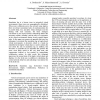Free Online Productivity Tools
i2Speak
i2Symbol
i2OCR
iTex2Img
iWeb2Print
iWeb2Shot
i2Type
iPdf2Split
iPdf2Merge
i2Bopomofo
i2Arabic
i2Style
i2Image
i2PDF
iLatex2Rtf
Sci2ools
ANSS
2006
IEEE
2006
IEEE
Moderating Simulation Lag in Haptic Virtual Environments
Simulation lag is a known issue in networked virtual environments where users are geographically distributed. When users collaborate across the network using haptics, there are always momentary lacks of synchronization due to packet delay, loss, and jitter. Many strategies exist for dealing with such scenarios, but these strategies concentrate on one aspect and don’t adequately address the necessary realism, causality, and the sense of co-presence in the virtual environments during closely-coupled haptic tasks. In this paper we propose an approach that uses two techniques to moderate the simulation lag in haptic-based virtual environments. A decorator, which is a visual cue embedded in the haptic virtual object, is used to inform the user about the sate of simulation lag. In addition, this decorator is controlled by an algorithm that predicts the users’ most likely action in the very short term, and compensates delayed or lost packets by interpolating collaborative actions. In oth...
| Added | 10 Jun 2010 |
| Updated | 10 Jun 2010 |
| Type | Conference |
| Year | 2006 |
| Where | ANSS |
| Authors | Azzedine Boukerche, Shervin Shirmohammadi, Abuhoss Hossain |
Comments (0)

